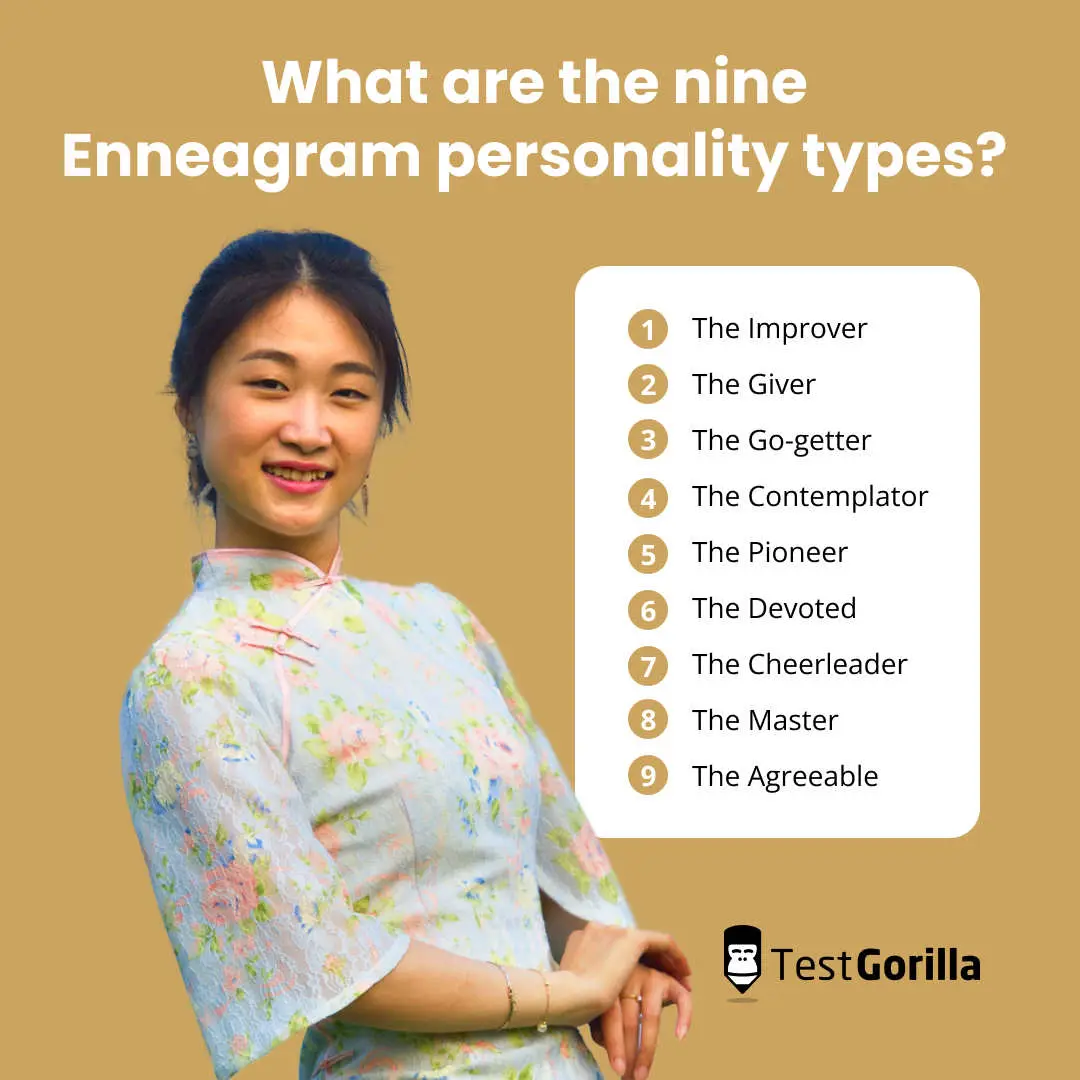There are so many pre-employment personality tests out there that it can be difficult to decide which is right for your hiring process.
The Enneagram Wings test is a popular option, but what does it measure? Can recruiters and hiring managers actually categorize each candidate or current employee into a personality type? And what is a “Wing,” exactly?
This article will dive deep into the Enneagram Wings test – covering how it works, its benefits, what Wings are, and the best test for your hiring process.
Table of contents
- What is an Enneagram personality test?
- What are the nine Enneagram personality types?
- What is an Enneagram Wing?
- Can people have more than one Wing?
- The difference between core type and dominant Wing
- Why are Wings important?
- Do Wings matter in the workplace?
- Can someone's Enneagram wings change over time?
- Which Enneagram test is suitable for a hiring campaign?
- Get started with TestGorilla's Enneagram test
What is an Enneagram personality test?
An Enneagram test identifies a person’s specific personality type. It follows a personality mapping framework that organizes human behavioral traits on a nine-pointed diagram called an Enneagram. Oscar Ichazo developed this framework in the 1950s, and psychiatrist Claudio Naranjo popularized it in the 1970s.
There are nine Enneagram personality types, and while most people find aspects of themselves in all of them, one type usually stands out as their core personality type.
An Enneagram personality test, like the one from TestGorilla, presents test-takers with a series of questions containing two statements. They must pick the option that best applies to them. Their choices reveal the core beliefs that influence their decisions, actions, and reactions to stress or opportunities.
Each of the nine personality types has a unique worldview. TestGorilla’s Enneagram Personality test results are organized in a comprehensive report that details each worldview, how they’re linked, and how they affect an individual’s personal and professional behavioral styles.
The report also teaches you how to interpret your candidate’s Enneagram types to benefit your hiring process by:
Improving communication and empathy
Managing professional development
Helping the interview process
It’s important to note that you shouldn’t rely solely on personality tests to make a hiring decision. Instead, use the Enneagram personality test alongside other multi-measure assessments to gain insight into candidates’ motivations and thought processes.
This gives you a well-rounded view of each candidate so you can be confident you’re hiring the perfect people for your open roles.
What are the nine Enneagram personality types?
Enneagram personality type | Description |
A rule-follower that always tries to do things the “right way.” They work hard but can prioritize thoroughness over getting the job done on time. | |
They always put others first. They’re caring and empathetic but may struggle to manage their own needs. | |
They’re highly motivated by recognition and positive feedback. They’re productive but can find it hard to see that they have value outside of their work. | |
They’re creative and authentic. They strive for meaning in their work and have a heightened emotional sensitivity that can lead them to take criticism too personally. | |
They’re perceptive, independent, and analytical. However, Pioneers can be self-contained, so they may have difficulty maintaining interpersonal relationships. | |
They’re loyal, perceptive problem-solvers who rely on rules to feel safe and secure. In the absence of structure, they can feel afraid and pessimistic. | |
They’re all about the positives. Their optimism and idealism can be infectious, but they struggle with details and engaging deeply with a subject. | |
They’re strong-willed and fair. They have a strong sense of justice but can dominate conversations. | |
They’re peacemakers who value inclusivity, patience, and harmony. They avoid conflict and can struggle to stay organized. |
What is an Enneagram Wing?
Imagine the nine Enneagram personality types in a circle. Each personality type has another type on either side. These are known as “Wings.”
For example, an individual with a Type Two Enneagram personality has Type One and Type Three as Wings, someone with a Type Five Enneagram personality has Type Four and Type Six as Wings, and so on.
Since a single personality type can’t encompass the entirety of an individual’s psyche, Wings represent additional layers that make up a person’s unique, blended personality.
Can people have more than one Wing?
Since the Enneagram isn’t an exact science, it's not unusual for people to have traits from both Wings in their personality types.
However, it’s much more likely that an individual will have a “dominant Wing” that explains the rest of their behavior and personality outside of their core type.
This means that an individual’s personality type is typically a combination of their core type and their dominant wing.
The difference between core type and dominant Wing
“Core type” is an individual’s main Enneagram type. It refers to the default strategic or decision-making process they use most often in their everyday life. It’s the driving force of their personality.
For example, someone with a core Type Two personality is called a Giver. Givers are warm and caring individuals who are particularly sensitive compared to other personality types. They prioritize forming and maintaining relationships with others and are quite successful due to their charisma, charm, and emotional intelligence.
Core Type Twos will most likely blend these traits with others from either Type One (the Improver) or Type Three (the Go-getter), which acts as their dominant Wing.
Simply put, the dominant Wing is the other side of an individual’s personality that explains the important traits that don’t quite fit – or may contradict – their core type.
For example, a core Type Two with a dominant Wing Three can be a Giver who’s more ambitious about their personal goals. They’re still charming and supportive, but they have a competitive streak and are more vocal about what they want.
In test results, the core type number is listed first, followed by a “w” and the dominant Wing number. For example, “2w3.”
Why are Wings important?
Wings are important because they provide a more nuanced depiction of job candidates and existing employees’ personalities.
Instead of labeling someone as one collection of traits, Wings offer a deeper look into how someone thinks and how their thought processes can evolve in a particular workplace.
Humans are complex and often contradict themselves; Wings map out that reality.
That said, core Enneagram types and Wings should be only part of your overall hiring process. You should also use other pre-employment assessments to evaluate candidates’ skills, abilities, and growth potential.
Do Wings matter in the workplace?
Yes, Wings matter in the workplace – but they shouldn’t be the be-all and end-all of your employee management process. They should be treated as an additional tool to monitor and support employee development.
Wings can give employees a nuanced understanding of how their worldviews impact their behavior in different professional situations.
For managers, Wings offer a detailed look at how their team members process emotions, how they work in groups, and what motivates them. Wings can also prevent managers from taking employees’ personality types at face value. This way, they can better understand how to support workers’ development.
Can someone's Enneagram wings change over time?
According to the Enneagram framework, a person’s two wings don’t change, but the dominance of a particular wing can fluctuate.
In other words, a person can switch their dominant wing on and their latent wing off in response to life events like a career change, a mid-life crisis, a traumatic experience, or a psychological breakthrough that changes one’s perspective.
The Enneagram Institute details these fluctuations through a system of nine levels a person can move up or down through. Created by Enneagram teacher Don Riso and developed by Riso and Enneagram Institute co-founder Ross Hudson, these levels are the building blocks of each personality type.
Level One is the “healthiest” level, where an individual is more present and less fixated on defending their ego. On the opposite end of the spectrum, Level Nine is the most “destructive” level, where a person is more likely to manipulate others to get what they want.
These levels account for the differences between people with the same Enneagram personality type, as well as how people and their Wings can evolve over time – for better or worse.
Which Enneagram test is suitable for a hiring campaign?
TestGorilla’s Enneagram Personality test is the best choice for a hiring campaign because it:
Outlines and explains the Enneagram personality mapping framework
Provides an in-depth personality type description
Explains how a candidate will behave in personal relationships and the workplace
Details their best attributes and main challenges
Offers tips for communicating with and developing unique personalities
Learning the ins and outs of each personality type is a great first step in your hiring campaign. Our Enneagram Personality test fits seamlessly within a larger pre-employment assessment process that will help you accurately predict job performance and identify which personality types will benefit your existing teams.
Recommended reading: Reasons to use an Enneagram test in the hiring process
Get started with TestGorilla's Enneagram test
The Enneagram Wings test is a great tool to uncover and map the personalities within your applicant pool. Understanding which of the nine core types your candidates have and how to support them is crucial to building a communicative, empathetic, and productive organization.
TestGorilla’s Enneagram Personality test takes this process further by providing a comprehensive overview of each candidate’s personality type, strengths and weaknesses, and the best way to manage their development if hired.
Start evaluating your candidates today by signing up for a free TestGorilla plan.
Related posts
Hire the best candidates with TestGorilla
Create pre-employment assessments in minutes to screen candidates, save time, and hire the best talent.
Latest posts
The best advice in pre-employment testing, in your inbox.
No spam. Unsubscribe at any time.

Hire the best. No bias. No stress.
Our screening tests identify the best candidates and make your hiring decisions faster, easier, and bias-free.
Free resources
This checklist covers key features you should look for when choosing a skills testing platform
This resource will help you develop an onboarding checklist for new hires.
How to assess your candidates' attention to detail.
Learn how to get human resources certified through HRCI or SHRM.
Learn how you can improve the level of talent at your company.
Learn how CapitalT reduced hiring bias with online skills assessments.
Learn how to make the resume process more efficient and more effective.
Improve your hiring strategy with these 7 critical recruitment metrics.
Learn how Sukhi decreased time spent reviewing resumes by 83%!
Hire more efficiently with these hacks that 99% of recruiters aren't using.
Make a business case for diversity and inclusion initiatives with this data.


















